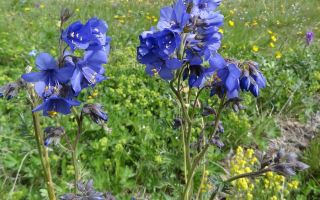Content
- 1 The chemical composition of the herb cyanosis blue
- 2 Useful properties of cyanosis herb
- 3 Harm of the grass cyanosis blue
- 4 Contraindications to cyanosis blue
- 5 Rules for the use of cyanosis blue
- 6 Application
- 7 Collection and storage rules
- 8 Conclusion
- 9 Reviews of the medicinal properties of blue cyanosis
Cyanosis blue or azure (Greek valerian) is a herbaceous perennial plant belonging to the order Heathers and the Cyanus family. It is widespread in the Russian Federation: in the Caucasus, in the taiga, in the central part of the country and in the Urals. It can be found in forests and forest-steppes, on nutrient-rich soils, along river banks and in flooded meadows. The healing properties of cyanosis blue have been known to folk healers for a long time. Scientific research of the herb was carried out in the 30s of the twentieth century. In the Soviet Union, a number of respiratory diseases were successfully treated with extracts and tinctures, and they were used as a sedative. With the advent of effective synthetic analogs, mass interest in cyanosis faded away.
The chemical composition of the herb cyanosis blue
The healing properties of cyanosis blue are due to the presence of valuable, biologically active substances in its composition. The chemical composition of the herbaceous perennial is varied:
- saponins, the main percentage of which is found in the roots, are natural glycosides that stimulate the gastrointestinal tract, cleanse blood vessels, normalize hormonal balance;
- starch and polysaccharides lower cholesterol levels, help regulate blood sugar;
- organic acids that help eliminate toxins and assimilate valuable nutrients;
- essential oils restore cells;
- resins have a noticeable antimicrobial effect;
- fatty oils slow down the aging process and normalize metabolism;
- trace elements - magnesium, selenium, manganese, zinc, barium, bromine, iodine, molybdenum, iron, silver, cadmium, aluminum - are the main raw materials for building cells, participate in metabolic processes and the work of all body systems.
In pharmacology, the roots and rhizomes of the flower are mainly used, which contain the greatest amount of nutrients.
A photo of a cyanosis blue flower surprises with its beauty.
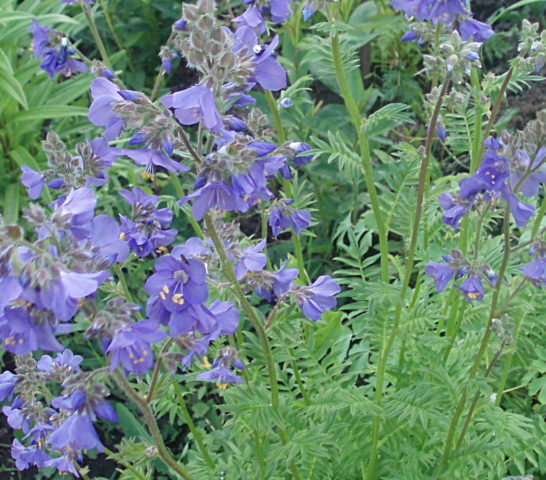
Useful properties of cyanosis herb
The roots of cyanosis blue have powerful healing properties. Seeds, stems, flowers and leaves of a plant are less useful, since the concentration of biologically active substances is reduced by 3-10 times. Cyanosis blue affects the human body as follows:
- Relieves inflammation, heals wounds.
- It removes phlegm from the bronchi and lungs.
- Treats gastrointestinal ulcers and gastritis with high acidity.
- Reduces cholesterol levels, removes atherosclerotic plaques.
- It has antifungal and antimicrobial effects.
- Stops bleeding, removes skin irritation.
- It has a pronounced sedative (calming) effect, therefore it is nicknamed valerian, and also acts as a sleeping pill.
- Reduces the risk of benign lesions.
- It is an effective prophylactic agent that prevents the formation of gallstones.
Popular rumor ascribes to the plant the ability to eliminate cravings for alcohol and remove nicotine addiction, but in this case, the effect of self-hypnosis is triggered. Its effect on cancer cells is also doubtful: laboratory studies have not confirmed the presence of such an effect from the application.
Harm of the grass cyanosis blue
For all its useful properties, blue cyanosis is far from harmless. You should be careful to self-medicate so as not to cause great harm to the body. The consequences of misuse or uncontrolled use are as follows:
- Severe nausea, vomiting.
- Diarrhea and shortness of breath.
- Sleepiness, lethargy.
- Urticaria, Quincke's edema.
- Dizziness, headaches.
You can not take the medicine on an empty stomach and if you have large kidney stones and gallbladder. With an exacerbation of chronic diseases of the gastrointestinal tract, one should refrain from using cyanosis blue without a specialist appointment. If negative symptoms appear, the drug should be discontinued.

Contraindications to cyanosis blue
The list of restrictions for receiving cyanosis blue is small:
- During pregnancy and breastfeeding;
- children under 1 year of age, with caution - up to 12 years;
- individual intolerance to the components;
- allergic reactions;
- high blood pressure;
- varicose veins and a tendency to thrombosis;
- stones in the kidneys and gallbladder.
Rules for the use of cyanosis blue
For effective treatment, it is necessary to observe these simple rules and restrictions, indications for use, doses and duration of the course:
- Raw materials obtained from blue cyan must be fresh, not expired, without mold, impurities and odors.
- It is necessary to strictly observe the recommended dosages, methods of preparation of decoctions and infusions.
- If you are taking other medications, collecting herbs, having a serious illness and having chronic diseases, you should consult a specialist before starting the course.
- The course of treatment and the regimen of administration must be agreed with the doctor.
- Taking a collection or tincture for the first time, you should carefully monitor the state of the body. If side effects appear, the course must be interrupted immediately.
Application
The use of the root and aerial parts of cyanosis blue in the treatment of various diseases is recommended by official medicine. In pharmacies, you can find medicines in the form of alcoholic tinctures, syrups, as well as herbal preparations in packaging. It is used to treat the following ailments:
- diseases of the upper respiratory tract and lungs - tuberculosis, bronchitis, pneumonia, whooping cough;
- CVS pathologies, the risk of heart attack or stroke, atherosclerosis, thinning of the walls of blood vessels, angina pectoris, arrhythmia, cardiosclerosis;
- neuroses, insomnia, epilepsy, vegetative-vascular dystonia, attacks of hysteria and irritability, increased anxiety;
- ulcers of the stomach and duodenum, inflammation of the gallbladder;
- internal bleeding, migraines, painful menstruation and the transition period with menopause;
- violation of carbohydrate metabolism, diabetes mellitus, high cholesterol;
- erectile dysfunction in men against a background of stress;
- children's neuroses, tantrums, fears;
- animal bites, including those with rabies, insects, snakes.
A course of cyanosis blue decoctions helps to increase efficiency, to normalize blood pressure.
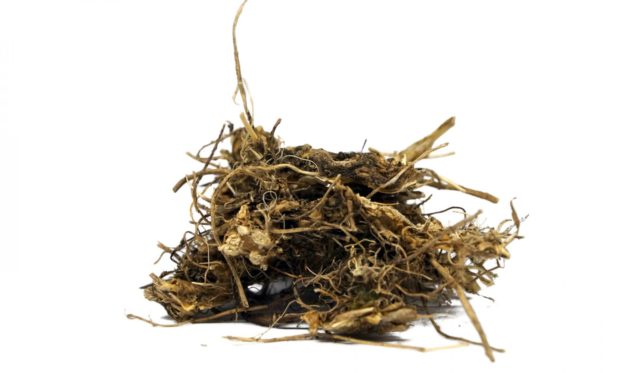
The use of cyanosis blue in traditional medicine
Fresh or dried cyanosis blue root, as well as other parts of the plant, are widely used in the recipes of traditional healers. Basically, raw materials are used in the form of decoctions and infusions on vodka and alcohol, mixed with other medicinal plants.
The most effective recipes:
- With insomnia and epilepsy 2 tbsp. l. dry root must be filled with a glass of water. Insist on a water bath for a quarter of an hour, cool, drain. Top up with boiled water until a glass is full. Take 20 ml 3-5 times a day 2 hours after meals.
- For gastritis with increased acidity of the stomach, put 20 g of dry grass in a thermos and pour a glass of boiling water. Insist for an hour. Filter, squeeze, add boiled water to 200 ml. Take after meals 15 ml 3-5 times a day.
- When coughing 40 g of dry root, pour 200 ml of hot water and put in a water bath for a quarter of an hour. Squeeze the raw materials, take 20 ml 2 hours after eating.
- If you suffer from insomnia, you should take 10 g of blue cyanosis root, mix with a handful of mint leaves and 15 g of hop cones. Pour a tablespoon of the mixture with 0.5 liters of boiling water in a thermos. Insist half an hour. Drink 15 ml 3 times a day after meals.
For a bath with psoriasis, prepare the following components:
- cyanosis blue dry root - 50 g;
- cyanosis leaves - 25 g;
- seeds - 25 g;
- spring water - 2.5 liters.
Pour the components with hot water, heat in a water bath for half an hour, insist in a thermos for 4 hours. Fill the bath with water with a temperature not higher than 45 degrees, pour the infusion. Take a bath for 15-30 minutes.
In traditional medicine
In pharmacies you can find dried rhizomes of cyanosis blue in packages of 25-100 g. Basically, decoctions from this raw material are recommended as an expectorant and sedative. It can also be used as an emetic and purifying agent for poisoning. Wipe the skin for allergies, dermatitis, itching.
Tincture of cyanosis blue instructions for use:
- cyanosis blue root - 5 g;
- alcohol 70% - 50 ml.
Grind the raw materials, add alcohol. Close tightly and place in a dark, cool place for a month. Apply 30-50 drops 3 times a day after meals. This tincture helps with bronchitis, ulcers and insomnia.
The syrup sold in pharmacies, in addition to the water extract of the root of cyanosis blue, includes heather and vitamin B6. It is indicated for depression and nervous disorders. Promotes the production of serotonin. Take 20-40 ml after meals for 1 to 1.5 months.
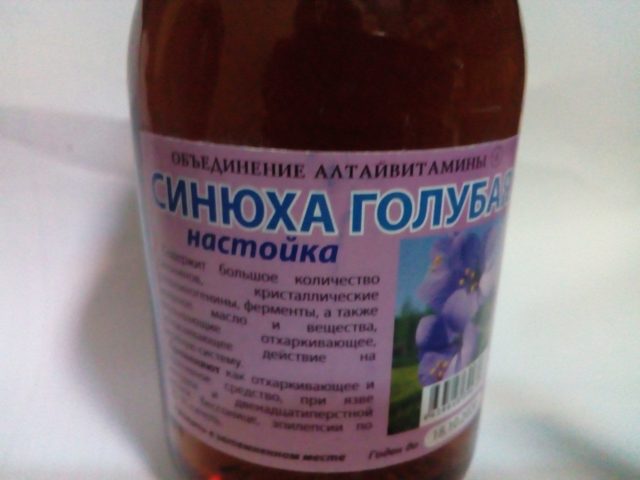
In cosmetology
Cyanosis blue is actively used for cosmetic purposes:
- a pronounced anti-inflammatory effect allows you to use a decoction of the plant to treat acne - just wipe problem areas or rinse with decoction 1-2 times a day;
- cool compresses from the broth on the eyelids relieve swelling, remove redness, give clarity to the look;
- for the treatment of seborrhea, you should use a decoction of blue cyanosis, take inside the herbal collection "Nervo-Vit", which, in addition to the root, includes valerian, lemon balm and motherwort.
A mixture of cyanosis blue with chamomile, thyme and linden blossom is an effective conditioner for hair. Maintains healthy shine, nourishes, strengthens. Apply 3 times a week to clean hair for 1-2 months.
Collection and storage rules
Cyanosis concentrates the greatest amount of nutrients in the second year of life, in the fall. It is during this period that roots and aerial parts can be collected for medicinal raw materials.
Here are the basic rules for collection and storage:
- It is necessary to leave part of the rhizome in the ground so that the cyanosis can grow back.
- Separate the collected roots, remove rotten and moldy parts, rinse well in several waters and dry.
- Cyan blue tops can also be used. Choose healthy, undamaged stems and bright green leaves.
- Cut the raw materials into small pieces and dry at a temperature of no more than 50 degrees. You can use an electric dryer, oven. Once the branches and roots are brittle, they can be poured into a box or linen bag.
It is necessary to store ready-made raw materials in a dark, cool place with good ventilation. Shelf life is 2 years. If the cyanosis blue has become moldy, absorbing moisture, or an odor appears, such a herb is not suitable for treatment.
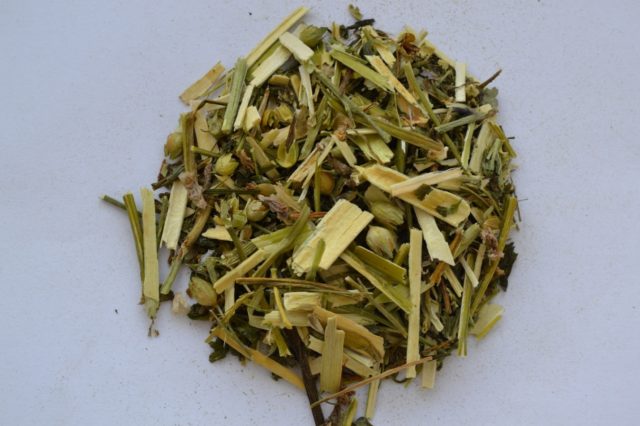
Conclusion
The medicinal properties of cyanosis blue were thoroughly studied at the beginning of the twentieth century. By the 60s, rhizome tinctures and decoctions were recommended as a sedative and expectorant. In folk medicine, decoctions and alcohol tinctures are used, including in a mixture with other herbs and fruits. Blue cyanosis is an unpretentious plant that can be planted on your own site, and you can harvest medicinal raw materials yourself. The drug has a number of contraindications, therefore, starting the course of treatment, you must monitor your condition or consult a doctor.
Reviews of the medicinal properties of blue cyanosis

